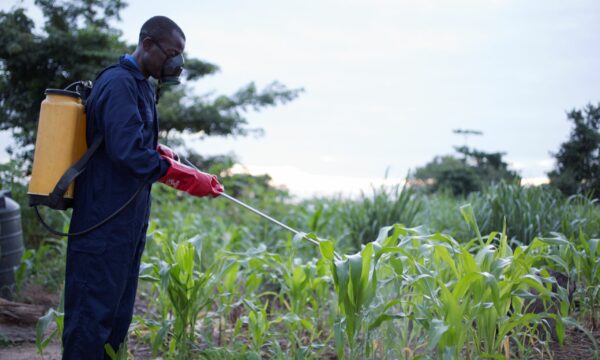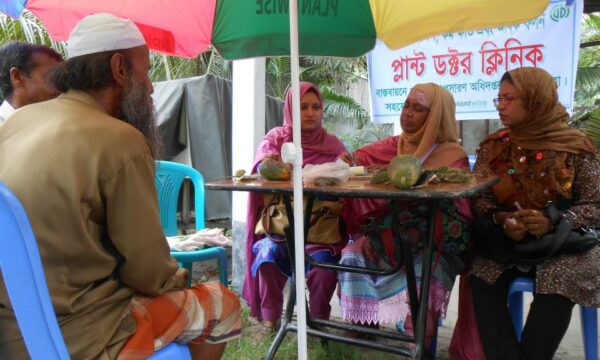The Mexican Fruit Fly Anastrepha ludens is the most important native fruit fly pest of citrus in America and also infests other economically important crops such as peaches, peppers and mangoes. In cooperation with the U.S. Department of Agriculture, Mexico has developed a Sterile Insect Technique (SIT) method which involves exposing huge quantities of male fruit flies to irradiation before releasing them en masse to mate with wild female flies. The male flies are exposed to enough radiation to sterilise them, so that mating with wild females results in the production of non-viable eggs. Over time repeated releases of large quantities of sterilised male flies causes the target pest population to collapse. The use of the SIT applied as part of an area-wide integrated pest management approach provides an environmentally safe and species-specific method to suppress, and in some cases eradicate insects of agricultural, veterinary and medical importance worldwide. The success of the SIT in effectively controlling target pest insect populations requires males to be able to successfully compete against wild unsterilized males to mate with females. Recent developments to improve SIT program effectiveness have been discovered by scientists from the Agricultural Research Service who found that the use of methoprene, an analogue of an insect hormone, and additional protein hydrolysate in the fruit fly diet helped to make sterilised males more “macho” by increasing their competitiveness in the wild, therefore making them more attractive as a mate to females.
The Sterile Insect technique was first pioneered in the 1950’s by entomologists Dr Raymond Bushland and Dr Edward Knipling and has since been used to successfully eradicate Screw-worm (Cochliomyia hominivorax), a veterinary and medical health pest from areas of North America and eradicate Mediterranean Fruit Fly (Ceratitis capitata) populations in Chile, Peru and southern Mexico. Successful use of the SIT greatly reduces the need for spraying broad spectrum insecticides, which can be harmful to non-target beneficial organisms and may lead to populations of insecticide resistant target pests developing if the insecticides are over-used.
Research by scientists in 2011 found that by combining methoprene treatment and protein hydrolysate into fruit fly diet reproductive development was accelerated and the competitiveness of sterilised fruit flies was increased. This meant that sterilised male flies could be released sooner, making the rearing and release program more efficient and cost effective. In comparison to untreated males the menoprene treated flies produce more pheromone and attract more females than flies that are just sterilised. These new methods are now being incorporated into the mass rearing of sterile flies for use in controlling the Mexican fruit fly in Mexico.
Current and future target insect pests for SIT programs include insects of medical importance such as Anopheles mosquitos that can transmit malaria, Aedes mosquitos that can transmit dengue fever and yellow fever and Tsetse fly, a vector of African Sleeping Sickness. Tsetse fly has already been eradicated from Zanzibar Island using the SIT. This recent research on reducing cost and increasing the effectiveness of the SIT in Mexican Fruit Fly control may lead to further research and adoption of the SIT technique to manage other pest insect species of agricultural and public health importance worldwide.
References:
Teal, P.E.A.; Pereira, R.; Segura, D.F.; Haq, I.; Gomez-Simuta, Y.; Robinson, A.S.; & Hendrichs, J. (2011), ‘Methoprene and protein supplements accelerate reproductive development and improve mating success of male tephritid flies’, Journal of Applied Entomology, DOI: 10.1111/j.1439-0418.2010.01606.x
Pereira, R.; Teal, P.E.A.; Conway, H.; Worley, J.; & Sivinski, J. (2011) ‘Influence of methoprene and dietary protein on maturation and sexual performance of sterile Anastrepha ludens (Diptera:Tephritidae), Journal of Applied Entomology, DOI: 10.1111/j.1439-0418.2011.01668.x
Gomez, Y.; Teal, P.E.A.; & Pereira, R. (2011), ‘Enhancing efficacy of Mexican fruit fly SIT programmes by large-scale incorporation of methoprene into pre-release diet’, Journal of Applied Entomology, DOI: 10.1111/j.1439-0418.2011.01695.x
2 Comments
Leave a Reply
Related News & Blogs
How do pest risk registers address the spread of plant pests in Africa?
Pest risk registers can help to solve problems in agriculture, addressing the growing global threat of plant pests. Moreover, changing weather patterns, led by rising temperatures, are causing them to reproduce faster and expand into new regions. In ad…
10 July 2025






A recent paper about Sterile Insect technique (SIT) being used as an environmentally friendly method of controlling the pink bollworm (Pectinophora gossypiella)
http://www.plosone.org/article/info%3Adoi%2F10.1371%2Fjournal.pone.0050922
Species-specific methods are certainly the future of pest control. All of us professionals are keeping our fingers crossed for more scientific research into environmentally friendly and innovative pest control methods! The biggest success would be an efficient program to inherit the mosquito SIT program that so many Westerners spoke against last year:
http://www.fantasticpestcontrol.co.uk/blog/researchers-intent-to-kill-mosquitoes-with-more-mosquitoes/